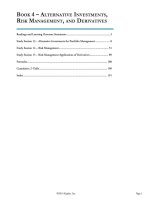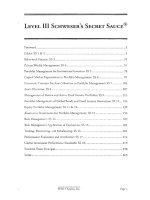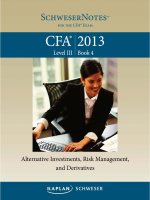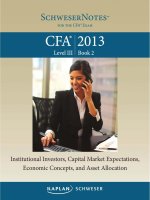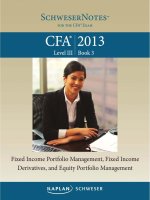CFA CFA level 3 volume III applications of economic analysis and asset allocation finquiz smart summary, study session 9, reading 19
Bạn đang xem bản rút gọn của tài liệu. Xem và tải ngay bản đầy đủ của tài liệu tại đây (94.22 KB, 6 trang )
2018 Study Session # 9, Reading # 19
“CURRENCY MANAGEMENT: AN INTRODUCTION”
FC = Foreign currency
DC = Domestic Currency
HR = Hedge Ratio
FI = Fixed Income
3. CURRENCY RISK AND PORTFOLIO RETURN AND RISK
3.1 Return Decomposition
Domestic asset⇒ asset that trades in the investor’s domestic currency.
Foreign asset ⇒ assets denominated in currencies other than the investor’s
home currency.
FC return ⇒ return of the foreign asset measured in foreign currency terms.
DC return ⇒ FC return + % movement in spot exchange rate
⇒ܴ = ሺ1 + ܴி ሻሺ1 + ܴி ሻ − 1
where
ܴி⇒ % ∆ in FC against DC.
⇒ The same formula is applicable to multi-currency portfolio of foreign assets.
⇒ Portfolio managers would need to account for the correlations (e.g. b/w
exchange rate movement, FC asset returns etc.) when forming expectations
about future asset price & exchange rate movement.
3.2 Volatility Decomposition
Above formula can be rearranged as:
ܴ = ܴி + ܴி + ܴி ܴி
Variance of the DC returns for the overall foreign asset portfolio:
ߪ ଶ ሺ߱ଵ ܴଵ + ߱ଶ ܴଶሻ ≈ ߱ଵଶ ߪ ଶ ሺܴଵ ሻ + ߱ଶଶ ߪ ଶሺܴଶሻ + 2߱ଵ ߱ଶߪሺܴଵሻߪሺܴଶሻߩሺܴଵ, ܴଶ ሻ
-ve correlation b/w variables will overall portfolio’s risk through
diversification.
Overall portfolio’s risk also depends on the ሺ߱ ሻ used.
4. CURRENCY MANAGEMENT: STRATEGIC DECISIONS
Various approaches to currency management are in place ranging from currency
risk avoidance to actively seeking FX risk.
Well-developed set of financial products & portfolio management technique are
available to manage currency risk.
4.1 The Investment Policy Statement
IPS mandates the degree of discretionary currency management that will be
allowed in the portfolio.
4.2 The Portfolio Optimization Problem
Optimization of multi-currency portfolio ⇒ selecting portfolio weights that
locate the portfolio on the efficient frontier of the trade-off b/w risk & expected
return defined in terms of the investor’s DC.
Portfolio managers usually handle asset allocation with currency risk as a two
step process:
Portfolio optimization over fully hedged return.
Selection of active currency exposure.
Copyright © FinQuiz.com. All rights reserved.
2018 Study Session # 9, Reading # 19
4.3 Choice of Currency Exposures
4.3.1 Diversification Considerations
Many investment practitioners believe that in the long run, currencies have
“mean reversion” feature (i.e. un-hedged currency exposure addition does not
affect long-run expected portfolio return).
Correlation b/w FC return & FC asset return tends to be for fixed income
portfolios than for equity portfolios.
Intuitive sense ⇒ bonds & currencies react strongly to movements in
interest rates.
4.3.2 Cost Considerations
Optimal hedging decision⇒ to balance the hedging benefits against hedging
costs.
Two forms of hedging costs include trading costs & opportunity costs.
4.4 Locating the Portfolio along the Currency Risk Spectrum
4.4.1 Passive Hedging
4.4.2 Discretionary Hedging
Goal is to keep portfolio’s currency exposure close to the
benchmark portfolio.
Rules based approach that removes almost all discretion
of portfolio manager.
“Neutral” benchmark exists as in passive hedging
however manager has some limited discretion.
Discretion is usually defined in terms of FC market value.
4.4.3 Active Currency Management
4.4.4 Currency Overlay
Extension of discretionary hedging.
No allowance for unlimited speculation.
Discretionary hedger usually protects the portfolio from
currency risk while active currency manager is supposed
to take currency risk for profit.
Currency overlay program ⇒ outsourcing currency risk
management task to a firm specialized in FX
management.
Currency managers are allowed to take directional views
on future currency movements.
One approach may be to separate the hedging & alpha
function (through overlay) mandates of the portfolio.
5. CURRENCY MANAGEMENT: TACTICAL DECISIONS
Tactical currency decision⇒ involves active currency management.
There is no simple formula, model or approach that will allow market
participants to precisely forecast exchange rates.
Copyright © FinQuiz.com. All rights reserved.
2018 Study Session # 9, Reading # 19
5.1 Active Currency Management Based on Economic Fundamentals
Developing a view about future exchange rate movements based on the underlying fundamentals.
Assumptions ⇒ In free markets, exchange rates are determined by logical economic relationships.
Model indicates that base currency’s real exchange rate should appreciate, if there is an upward
movement in:
Long run real exchange rate.
Real or nominal interest rates.
Expected foreign inflation.
The foreign risk premium.
Challenges ⇒ to model movements in real exchange rates & changes in other variables overtime.
5.2 Active Currency Management Based on Technical Analysis
Based on three broad themes:
First ⇒historical price data can be helpful in projecting future price movements.
Second ⇒ historical patterns in the price data have a tendency to repeat.
Third ⇒ technical analysis does not attempt to determine where market prices should
trade but where they will trade.
Technicians try to identify when markets have become overbought or oversold to identify
reversal or correction.
Many FX active managers use technical analysis to form a market opinion or to time
positions, entry & exit points.
5.3 Active Currency Management Based on the Carry Trade
Carry trade ⇒ strategy of borrowing in low-yield currencies & investing in high yield
currencies.
Forward rate bias ⇒ forward rates are biased predicator of future spot rate.
Forward premium (discount) overstates the amount of appreciation (depreciation).
Trading the forward rate bias ⇒ buying (selling) currencies selling at a forward
discount (premium).
The Carry Trade: A Summary
Implementing the carry
trade
Trading the forward
rate bias
Buy/Invest
High-yield currency
Sell/Borrow
Low-yield currency
Forward discount
currency
Forward premium
currency
Reference: Level III Curriculum, Volume 4, Reading 18.
5.4 Active Currency Management Based on Volatility Trading
Trading style is unique to option markets & is known as volatility trading.
Volatility trade can be implemented through straddle.
Straddle ⇒ combination of both at-the-money put & call
Profitable in more volatile markets.
Strangle ⇒ buying out-of-the money put & call.
Cheaper to take positions.
Volatility overlay programs, for actively trading the portfolio’s exposures to
movement in currencies’ implied volatility, are also available.
Copyright © FinQuiz.com. All rights reserved.
2018 Study Session # 9, Reading # 19
6. TOOLS OF CURRENCY MANAGEMENT
6.1 Forward Contracts
Future or forward contracts on currencies can be used to obtain full currency
hedge.
Institutional investors prefer forwards over futures based on the following reasons:
Due to standardization, futures contracts may not correspond to the portfolio’s
investment parameters.
Futures contracts may not be available in currency pairs required for hedging.
Futures contracts require upfront margin.
6.1.1 Hedge Ratios with Forward Contracts
Actual HR may drift away from desired HR as
market conditions change.
Static hedge ⇒ avoid transaction cost but
accumulate unwanted currency risk.
Dynamic hedge ⇒ rebalance the portfolio
periodically to manage the currency risk.
Actual HR remains close to target HR.
Risk aversion, frequency to hedge.
6.1.2 Roll Yield
Forward contracts are priced at spot rate adjusted for the no. of forward points at the
maturity.
Forward points may be at premium or discount (+ve or –ve roll yield) depending upon
buying /selling in the market.
The Carry Trade and Roll Yield
Implementing the
carry trade
Trading the forward
rate bias
Buy/Invest
High-yield currency
Forward discount
currency
Sell/Borrow
Low-yield
currency
Forward
premium
currency
Earning a
positive roll
yields
Reference: Level III Curriculum, Volume 4, Reading 18.
6.2 Currency Options
Forward contracts hold opportunity cost if future currency moves are in portfolio’s favor.
Options remove this cost by providing right but not obligation to buy FX at agreed upon
price in future.
Protective put ⇒ matching a long position in the underlying with a put option.
Option cost is the premium paid to enter into an option (based on its intrinsic value & time
value).
6.3 Strategies to Reduce Hedging Costs and Modify a Portfolio's Risk Profile
Cost-reduction measures, invariably involve some combination of less downside protection &/or less
upside potential for hedge.
Hedge ratio may drift from 100% to some directional positions in order to reduce cost.
Select Currency Management Strategies
Forward Contracts
Option Contracts
Exotic Options
Over-/ under-hedging
OTM options
Risk reversals
Put/call spreads
Seagull spreads
Knock-in/out features
Digital options
Profit from market view
Cheaper than ATM
Write options to earn premiums
Write options to earn premiums
Write options to earn premiums
Reduced downside/upside exposure
Extreme payoff strategies
Reference: Level III Curriculum, Volume 4, Reading 18.
Copyright © FinQuiz.com. All rights reserved.
2018 Study Session # 9, Reading # 19
6.3.1 Over-/Under-Hedging Using Forward Contracts
Manager can add incremental value based on market view (subject to IPS
permission).
If base currency is likely to depreciate (appreciate) then over (under) hedging might
be implemented.
Variant of this approach ⇒ ( ) the hedge ratio if base currency depreciates
(appreciates).
Form of delta hedging.
6.3.2 Protective Put Using OTM Options
To reduce cost of using options, accept some downside risk by using an OTM
option (e.g. 25 or 10 delta option).
It is rational to have a cheaper insurance policy & accept responsibility for minor
events.
6.3.3 Risk Reversal (or Collar)
Writing options to earn income that can be used to offset the cost of buying put
options.
Cheap downside protection compared to protective put ⇒ buy an OTM put & write
an OTM call option.
Risk reversal ⇒ long call & short put in FX markets.
6.3.4 Put Spread
Put spread is used to upfront cost of buying a protective put.
Put spread ⇒ buying put + writing put.
6.3.5 Seagull Spread
Seagull spread ⇒ long protective put & write both a call & a deep
OTM put.
6.3.6 Exotic Options
Usually used by currency overlay managers.
Vanilla options ⇒ European style put & calls options.
Exotic options ⇒ options that are not vanilla.
Option with knock-in (knock-out) features ⇒ vanilla
Option that is created (ceases to exist) when spot rate touches
some pre-specified level.
6.4 Hedging Multiple Foreign Currencies
Very similar to hedging single currency but must consider correlation
b/w various foreign currency risk exposures.
Copyright © FinQuiz.com. All rights reserved.
2018 Study Session # 9, Reading # 19
6.4.1 Cross Hedges and Macro Hedges
Cross (proxy) hedge ⇒position in one asset is used to hedge the risk exposures of a
different asset.
Macro hedges are some types of cross hedges.
Reason ⇒ entire portfolio is the focal point.
6.4.2 Minimum-Variance Hedge Ratio
A mathematical approach to determine the optimal cross-hedging ratio.
Minimum variance hedge ratio typically applies only for indirect hedges based on
cross hedging.
6.4.3 Basis Risk
Basis risk ⇒ risk to portfolio when a direct currency hedge is replaced with indirect
hedge.
All cross hedgers & macro hedges will have to be carefully monitored & rebalanced
to account for the drift in correlation.
7. CURRENCY MANAGEMENT FOR EMERGING MARKETCURRENCIES
7.1 Special Considerations in Managing Emerging Market Currency Exposures
Two important considerations:
Higher trading costs than the major currencies.
Chances of extreme market events & severe illiquidity.
Higher costs would especially be the case for crosses in currency pairs.
When trades in these less liquid currencies get crowded, liquidity becomes an
issue.
Forward contract based hedging strategies also affect from currency crises.
7.2 Non-Deliverable Forwards
Non-deliverable forwards ⇒ similar to regulated forward contract but these are
cash settled.
NDF has lower credit risk than outright forward (as principal sums in the NDF don’t
move).
Copyright © FinQuiz.com. All rights reserved.

